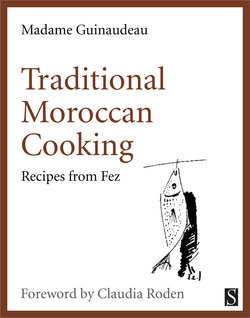Читать книгу Traditional Moroccan Cooking - Madame Guinaudeau - Страница 2
На сайте Литреса книга снята с продажи.
FOREWORD
ОглавлениеWhen years ago I travelled to research Morocco’s cooking, Madame Guinaudeau was mentioned to me by everybody I met and I talked to several people who boasted that they had given her recipes. They all spoke of her with affection and respect. Today, although a number of books have appeared on the subject of their country’s cuisine, a younger generation of Moroccans has the greatest respect for Madame Guinaudeau’s Fès Vu par sa Cuisine, first published in 1958 and translated here as Traditional Moroccan Cooking: Recipes from Fez. That the most exclusive restaurant in Fez has been called Fés Vu par sa Cuisine is an indication of the high regard in which the book is held. Moroccans are immensely proud of their cuisine and rightly regard it as one of the best in the world, so for a foreign author to be so highly esteemed by them is no small accolade.
By all accounts the book was the first on Moroccan cooking since an anonymous compilation of Maghrebi and Andalusian recipes appeared in Arabic in Spain in the twelfth century. (As her book went off to press Madame Guinaudeau added a note that she had thought she was the first person to write about Moroccan food, but that after writing it she heard that a work by John, 4th Marquis of Bute, entitled Moorish Recipes was published in Edinburgh in 1955.) That is merit in itself, but the book is also remarkable in many other ways. There is in Madame Guinaudeau’s writing a truth and authenticity which is rarely found in cookery books. Every recipe, every description, every detail of people’s lives which she gives is the result of her own observation, which makes her book completely original and absolutely unique; there is passion and enthusiasm which comes through in every page.
Perhaps it is because she was an outsider that she had such a fascination with and respect for her subject, and also a concern to avoid the phoney. The wife of a French doctor – a much-loved eye specialist – she moved to Fez in 1929 and lived there for more than three decades. She made it her joy to pursue recipes and culinary information in the kitchens of Fez, which became her beloved city. It was also a way of getting to know the people. She was invited to eat and to watch the cooking operations in modest and grand homes in the casbah and the medina as well as in the palaces of the aristocratic families, in ethnic communities like the Jews in the mellah (the city’s old Jewish quarter) and primitive Berber villages outside the city.
The book took her twenty years to research. Ahmed Sefrioui wrote in the preface to the first edition that it was a contribution to the history of his country, a document of great human interest. Madame Guinaudeau described the way people lived and entertained, the protocol of their banquets, the activities of the kitchen and the public bakehouse, and brought a whole mysterious world to life. She said she wanted to make the sparkle of the copper pots sing for us and to let us feel the rustic textures of the clay and the wood, and she succeeded. We can feel what it is like to sit in an indoor courtyard with turquoise and cobalt tiles and water running from a fountain, the scent of jasmine mingling with the smells of a stew simmering in the burning midday sun, and what it is like to pass a spice shop in the souk and see the seeds and pods and contorted pieces of bark and piles of spices and rosebuds while the mingled smells hang like a thread around the warren of narrow streets.
Her second, much larger book, Les Secrets des Cuisines en Terre Marocaine on the regional cooking of Morocco, published in France in 1981 under her full name Zette Guinaudeau-Franc, incorporates the entire first book. She explains that the dishes of Fez have such a major place in it because they are the country’s most refined. Fez is indeed famous for her cooking. It is an immensely varied and surprising cuisine which mixes ginger and hot chilli pepper with honey and sugar and marries meat with fruit. It is colourful and aromatic and makes use of a very long list of spices which are always used with a delicate hand. The Arab cooking of Baghdad during the Abbassid Caliphate, Andalusian styles brought back by the returning Moors after the Catholic Reconquista of Spain, Ottoman Turkish specialities arrived through the occupation of Tetuan, ingredients from Africa and of course the old traditions of the indigenous Berbers all played their part in creating this prestigious cuisine.
Madame Guinaudeau’s ambition was to fix the cooking traditions of Fez before they were transformed by contact with Europe. Now that Moroccan cuisine has become fashionable and is appreciated as one of the tastiest and most sophisticated of the Mediterranean, her work is more important than ever. Of course we do not want to spend hours in the kitchen as they did decades ago in Morocco, and we will make things easier for ourselves with pre-cooked packet couscous and our own shortcuts, but we need to know without simplification or embellishment how the real thing was and still is in most Moroccan homes. Traditional Moroccan Cooking: Recipes from Fez is a classic of lasting value which brings it all to us in a most engaging way.
Claudia Roden
